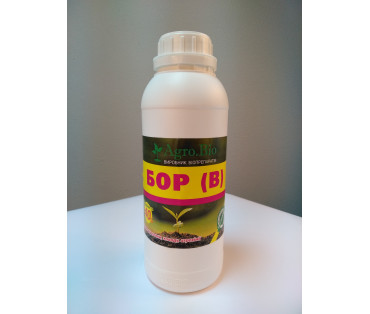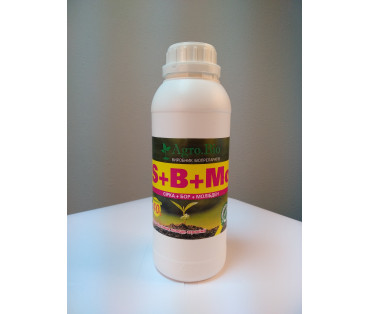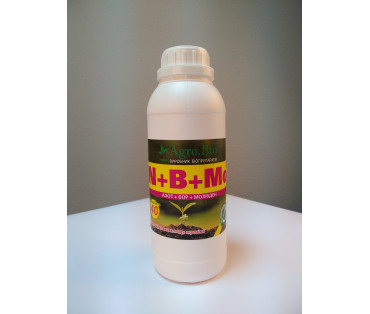Boron (B) is a medium-active trace mineral not included into the group of metals, which is especially important in plant nutrition and propagation
Boron (B)is a medium-active trace mineral not included into the group of metals, which is especially important in plant nutrition and propagation, after zinc, none of the metabolic processes passes without boron (synthesis of carbohydrates, protein biosynthesis - synthesis of nucleic acids (DNA, RNA), photosynthesis (activates the formation of chlorophyll, assimilation of CO2), phytohormones, transport of sugars), acts as a regulator when using stimulants and inhibitors for growth and development of crops, enhances the formation of nodule nitrogen-assimilating bacteria, activates the effect of enzymes, distributes growth regulating substances, ascorbic acid from leaves, roots to the reproductive organs.
Plants need boron during the entire vegetative period to form vegetative (especially young roots) and reproductive(flowers, in the formation of pollen, seeds) organs; boron participates in the formation of cell walls, plant tissue structures, in the processes of cell fission, accelerates the processes of flowering, formation of seeds, promotes fertilization and increases seed growing potential, forms the plants' resistance to diseases; but it is not able to redistribute between organs within the plant. Most of the boron is localized in ovary, pollen, stamens and accumulated in leaves, flowers, less represented in roots, and is absent in the stems. Vegetable and fruit and berry plants require 10 times more boron than cereal crops.
Boron deficiency: the insufficient amount of boron leads to the drying of vegetative tips, the dieback of apical points, roots, leaves, weak flowering or its absence; small twisted leaves that yellow appear; when the fruit is formed quantitative and qualitative indicators decrease. Lack of boron leads to the development of diseases (for beets – chlorosis of leaves, dry rot; for flax – bacterial blight; inflorescence of cauliflower – is getting brown, hollow heart is appearing; for grapes – declines; for apples – black rot; for pears – corkiness, watery spots), also the difficulties appear with the fixation of nitrogen from the air by plants. The shortage of boron appears under excessive introduction of nitrogen fertilizers or liming of soils, as well as under drought conditions, especially on carbonate and waterlogged soils.
Abuse of boron nutrition: leads to the formation of twisted, deformed leaves with small brown spots; in a certain period spots increase in size, leaves die starting from the lower part of the old leaf blades; rubescence of leafstalk may also appear; the flowers are formed smaller with lighter color, and the plant wilting is observed.
Boron interinfluence with other elements
| Antagonists (overbalance of one triggers a deficiency of another element) | Synergist (improve mutual properties of each other) | Block the each other interaction (it is not recommended to combine together) |
| - | - | Ca (calcium) |
Related Products
Humate + Bor «Agro.Bio»
B (Boron) provides almost 100% penetration into the plant organism during foliar feeding. It is also directly involved in the transport of sugars, the synthesis of lignin, which is necessary for the f..
$11.00
Sulfur + Boron + Molybdenum «Agro.Bio»
In the soil, sulfur is present in plant organic residues and humus (in this form it is not available for the plant organism), it is necessary for the transformation of sulfur in the direction of miner..
$13.00
Nitrogen + Bor + Molybdenum «Agro.Bio»
The importance of nitrogen in plant life can hardly be overestimated. It is the main macronutrient, due to which the vegetative mass of the plant increases. Nitrogen plays the role of the main buildin..
$11.00
Related Articles
Effect of Humic and Fulvic Acids on Phosphorus Uptake in Plants Depending on Environmental Temperature
The stimulating effect of humic and fulvic acids on plants has been noted by various scientists, including specialists from the mineral fertilizer manufacturer Agro.Bio, but the ..




-370x314.jpg)